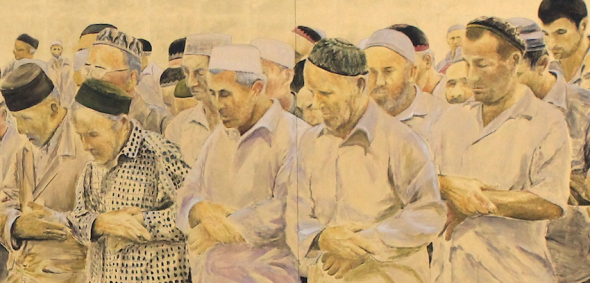The annual arts festival 48 Stunden Neukölln returned this past weekend, creating an attitude of positivity and openness within an arts festival rather than one based on celebrity artists or sales. The festival’s local, discursive art is meant to be open and welcoming, and its short weekend-long timeframe truly impressed on us how many artists and supporters are present in just one Bezirk of Berlin.
For its 16th year, the festival hosted over 250 events and exhibitions from pop-up spaces to bars, and even at the shopping mall. The thematic focus for the artworks was “Courage,” and many of the works reflected this theme with a political edge. This came across strongly at the multi-media exhibition in the Neukölln Arcaden, where a third-floor, cavernous storefront was transformed into a gallery for the weekend.
 Barbara Duisberg – “Tschetschenien” (2013), 200 cm x 480 cm, acrylic on hammered metal; courtesy of the artist
Barbara Duisberg – “Tschetschenien” (2013), 200 cm x 480 cm, acrylic on hammered metal; courtesy of the artist
Families with strollers, artists themselves, and even perhaps those whose intentions were to actually shop at the mall, permeated the space even on Sunday afternoon. Barbara Duisberg‘s paintings situated viewers into protest scenes painted on sheets of hammered gold. Though we were first attracted to the sheen, the emotions of the scene quickly reverberated. Her scenes are not romanticized protests but journalistic photographic scenes taken from places such as Chechnya.
Though many of the pieces have a sense of political urgency, a few of them also demonstrated some sort of courage in criticizing the art world and its hierarchy. Annette Hollywood‘s 15 minute film “Hit (by Great Art),” jabbed at the politics of the art market. We see the bird-boned gallerist interacting with a young and up-and-coming artist whose whole schtick is his use of gold. As they tilt their heads gazing at a canvas, trying to see what isn’t quite right, the artist simply hangs a gold jacket on the corner and calls it a day. This hard work is immediately rewarded with champagne. We witness opening night at the gallery, including the skeptics, those who defend the artist’s work fiercely, and his ‘frenemies,’ all talking about his work. The final scene follows the young artist to a studio where he is greeted by a woman who, through following their conversation, we learn is the real artist: he is only the ghost artist. The piece reflects the sexism inherent in the art world.
Though the film was light, humorous, and a bit quick to condemn at the end, it seemed to represent the attitude of 48 Stunden. Calling bullshit is refreshing once in a while, and even better when you have something to offer in response.
Their marketing materials this year were simple and ubiquitous, reading “Hier ist Kunst.” This was an event that wanted a wide audience, and offered experiential and interactive art in return. The “Be a Collector in 5 Minutes” piece allowed anyone to collect, hang, and pose with their art. 48 Stunden opposes the part of the art world that tip-toes around each other in fear of reducing their social status and, instead, brings forth a celebratory event that’s confident and unafraid.
___________________________________________________________________________________
Additional Information
www.48-stunden-neukoelln.de
___________________________________________________________________________________
Blog entry by AJ Kiyoizumi in Berlin; Friday, Jul. 04, 2014.


























